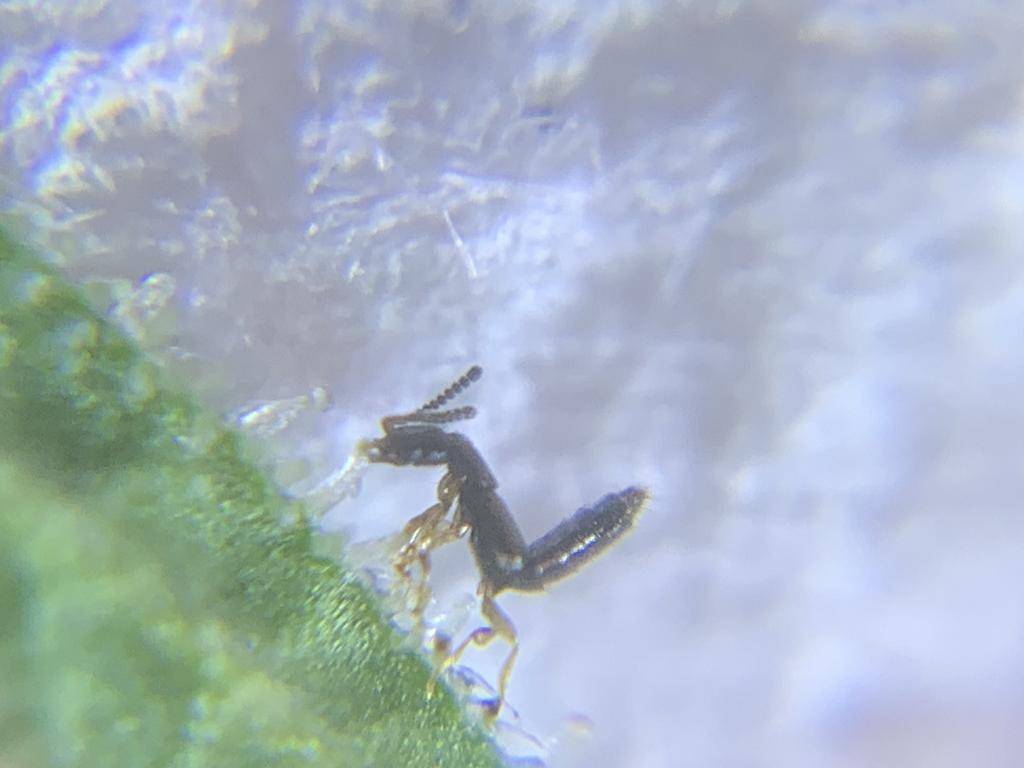I have been growing for a long time and have fought many pests. I’ve never seen these on my plants before. I don’t know of any damage, I’ve just found them stuck in the triches of my GG girls that are 7wks into flower. Which I had to harvest early due to mold.

-
Happy Birthday ICMag! Been 20 years since Gypsy Nirvana created the forum! We are celebrating with a 4/20 Giveaway and by launching a new Patreon tier called "420club". You can read more here.
-
Important notice: ICMag's T.O.U. has been updated. Please review it here. For your convenience, it is also available in the main forum menu, under 'Quick Links"!
You are using an out of date browser. It may not display this or other websites correctly.
You should upgrade or use an alternative browser.
You should upgrade or use an alternative browser.
Insect ID request
- Thread starter ScrogMonster
- Start date
The antennae of ants have an 'elbow'. That appears to be a springtail. Springtails in large numbers can be a nuisance, but they are not considered to be harmful to plants.
Springtails
Springtails
Quick facts
Springtails are found in areas of high moisture and in organic debris.
They are nuisances and do not damage food, clothes, furniture or property.
Springtails do not bite or sting and are harmless to people.
They feed on decaying roots and fungi and rarely damage plants.
Moisture control is the most effective option for controlling springtails.
Many light colored flea-like insects on a dark background
Common soil springtail
Yellowish flea-like insect with 6 legs, 2 antennae, and a tail-like structure
How to identify springtails
Most springtails are dark-colored, brown, grey or black. Some species maybe white and some are even brightly colored.
Usually slender, elongate insects, but there is a group that is round and stout
Very small, between 1/16th and 1/8th inch long
Moderate length antennae
Springtails do not have wings and cannot fly. But they can jump up to several inches using a special forked structure under the abdomen.
Springtails and fleas maybe of the same size, but have differences in their structure.
Fleas are flattened from side to side and have very hard bodies, making them difficult to kill by crushing.
Springtails have a more rounded, soft body and are easily crushed.
Where do you find springtails
Outdoors, springtails can be found feeding on fungi, pollen, algae or decaying organic matter. You can find lots of springtails in mulch .
When springtails are found close to the home in high moisture conditions, they may eventually move indoors. In dry outdoor conditions, springtails may move inside to look for moisture.
Indoors
Find springtails in areas of high moisture and condensation (around plumbing leaks in bathrooms, basements and kitchens).
Springtails are commonly found in the soil of overwatered houseplants.
They prefer soil that is excessively damp or soil mixes that contain a high percentage of peat.
Four black-colored flea-like insects on snow
Snowfleas are a springtail species found in snow
Springtails in winter
Snowflea (Hypogastruna nivicola) is a springtail species that is active during winter and seen on snow.
Snowfleas are harmless springtails that become active as soon as the ground begins to thaw in late winter or very early spring.
They are generally found in groups and their dark colored bodies are easily noticed against white snow.
How to manage springtails
When you see large numbers of springtails, it means there is a high moisture problem. Springtails are generally a temporary problem and die when moisture levels are reduced.
Check inside and outside of the house for moisture problems
Moisture causing issues:
Rainspouts that do not carry water far enough away from the foundation.
Landscapes that slope towards buildings.
Excessive irrigation.
Non-functioning drainage systems around the building.
If you see small numbers of springtails, ignore them or physically remove them by hand or with a vacuum. For larger infestations:
Dry out wet areas with a fan or dehumidifier.
Remove wet wood, especially if it is moldy.
Make structural changes to correct moisture problems.
Remove or reduce the amount of mulch around the foundation of your home.
If you have a problem with springtails in houseplants, let the soil dry out and water less frequently but more deeply.
Pesticides are not effective against springtails and should not be used.
imiubu
Well-known member
Wow, excellent photo. Looks like that critter is munching on a trichome, dang.
So many types of Springtail's but the antenna on your lil guy leads me to think that buzzmobile has identified your culprit, hopefully anyway.
Let us know the treatment/ outcome please.
Best of luck.
So many types of Springtail's but the antenna on your lil guy leads me to think that buzzmobile has identified your culprit, hopefully anyway.
Let us know the treatment/ outcome please.
Best of luck.
Are you growing in soil? If they are springtails there should be many more crawling around on the soil surface.
Thanks for the replies everyone. Buzzmobile - Thanks, I kind of figured it could be an bigger black more adult version of those crazy little white thread looking spring tail freaks that I see in my soil fairly regularly. I had never seen this version of them until now though.
I wonder if they could have helped cause the mold issue. I know from experience that gnats getting stuck in thick frosty buds can cause mold. I didn't find any springtails in the moldy buds though like I would find a fungus gnat stuck in a bud with the mold spreading from the spot.
I wonder if they could have helped cause the mold issue. I know from experience that gnats getting stuck in thick frosty buds can cause mold. I didn't find any springtails in the moldy buds though like I would find a fungus gnat stuck in a bud with the mold spreading from the spot.



